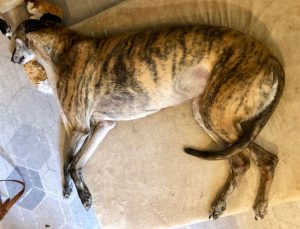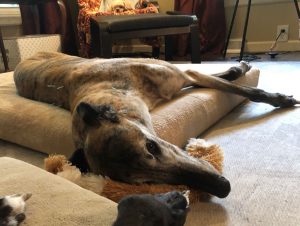Written by a CuraCore Veterinary Medical Acupuncture course graduate. Signed release obtained from client/author. 4D2019017
Abstract
A 9-year-old retired racing and ex-blood donor greyhound presented for moderate thoracolumbar pain and was treated using dry needling techniques over a series of three treatments. The patient is also a known epileptic and has sufficient seizure control with the use of levetiracetam (Keppra). Owners have noted significant improvement in the patient’s activity level (willingness to run and play) as well as comfort during grooming sessions.
History
Wilbur is a 9-year-old male neutered greyhound presenting for mid-thoracic pain and intermittent decreased levels of activity. Wilbur has been with his current owner for the past 4 years. Previously, owner believes he was a racing greyhound for approximately 2 years before retirement to become a blood donor at University of Missouri School of Veterinary Medicine. When Wilbur was 4 years old, he had his first seizure and was subsequently diagnosed with epilepsy (unknown diagnostics). It was around this time that Wilbur was adopted by his current owner. He was started on phenobarbital (unknown dose) that controlled seizures well for 2 years; he did not have any seizures. Since Wilbur had done so well, he was switched to 1000 mg XR levetiracetam (Keppra) BID. He has been on Keppra for 2 years and has about 3-4 breakthrough seizures per year (lasting less than 2 minutes each). Wilbur began to develop thoracic pain a couple of years ago, no known trauma. He had radiographs taken, these were normal and did not indicate orthopedic involvement at this time. Owner has taken more conservative approach in order to avoid long term medications, she elects for acupuncture to help reduce his pain. Wilbur lives with his two humans and six other animal house mates (2 greyhounds, 2 small mix breed dogs, and 2 cats). He goes on walks regularly (several times a week) to the park and to run at the baseball diamond. Wilbur loves to sprint a couple of laps and is then happy to sniff and sleep in the sun. Occasionally, Wilbur will be much slower to move, avoid his normal sprints, and owner attributes this sign to his back pain. In spite of this, Wilbur is still spunky and has lots of personality (as seen in his videos).
Physical examination
In order to address his discomfort, I performed a thorough myofascial exam. On initial exam, Wilber has taught bands throughout his left brachiocephalicus muscle, there are trigger points located in the ventral portion of the muscle. His rhomboideus, thoracic trapezius, and triceps muscles are hypertonic bilaterally. There is a trigger point located in the mid-body of the left triceps. He has moderate kyphosis located at the thoracolumbar junction and tenderness to palpation along the inner and outer bladder line from mid-thorax to mid-lumbar segments. He has increased pain response at L4/L5. Wilbur’s hamstrings and quadriceps are moderately hypertonic. Neurologic exam is within normal limits.
CBC and Serum Chemistry performed in 2018 were within normal limits. Radiographic images of spine are within normal limits according to owner. There is no evidence of infection, subluxation, luxation, fracture, arthritis, or narrowing of disc spaces. Suspect the majority of discomfort has a soft tissue origin.
Problem list
Seizures occurring 3-4 times per year
Thoracolumbar pain
Intermittent decreased activity levels
Moderate dental disease
Differential diagnosis
Seizures: Epilepsy, brain tumor, thromboembolism, tick-borne (Borellia burgdorferi), arteriovenous anomalies, head trauma, insulinoma, encephalitis, granulomatous meningoencephalitis, dietary deficiency, lipid storage disease, lead poisoning
Musculoskeletal pain: Arthritis, muscle strain patterns/compensation; subluxation, luxation, fracture, discospondylitis, intervertebral disc disease (IVDD) (chronic), thromboembolism
Diagnoses (describe why)
Epilepsy is the most likely diagnosis based on age of onset and significant control over seizures with one seizure medication, no other systemic signs of disease are noted. MRI and spinal tap would be needed for definitive diagnosis but I consider epilepsy highly likely.
Myofascial restriction and muscle compensation, rule out mild to moderate arthritis (recommend additional radiographs of the spine). Remainder of differentials can be ruled out based on diagnostics, IVDD less likely due to static nature but cannot be ruled out with MRI.



Treatment plan
Initial treatment was aimed at getting familiar with Wilbur and determining his level of acceptance of acupuncture using dry needling technique. I began with parasympathetic stimulation points, GV14 and GV20, plus Bai Hui to stimulate the autonomic nervous system. Once I knew he was comfortable (noted by his sleeping) then I proceeded to target the spinal erector muscles. I began with BL11 and BL13 to determine his tolerance. Next I moved to trigger point in left brachiocephalicus muscle and finally bilateral BL21, the most sensitive region of his back. He has a significant twitch response during bilateral BL21 placement.
I targeted the bladder line specifically because the cause of his pain is likely associated with the thoracolumbar junction. By beginning away from the most sensitive region, I can still target the iliocostalis and longissimus dorsi muscle feedback mechanisms to decrease tone. By needling BL11 and BL13 I am using the central nervous to send feed back to the entire muscle. When I needle BL21, I am targeting the peripheral nervous system and myofascial dysfunction. The local trigger point needles also act to alleviated myofascial dysfunction.
While I am targeting the parasympathetic nervous initially to determine Wilbur’s reaction and willingness for acupuncture, this may also have an effect on his overall brain activity. By upregulating the parasympathetic nervous system, this could potentially act to maintain homeostasis needed for decreased frequency of seizures. However, I recommend continued medication as there is no research to support acupuncture as a therapy for epilepsy (Cheuk and Wong, 2014).
Treatment
All treatments were performed with Seirin J type (0.2x30mm) needles. See images “Wilbur-Treatment1”, “Wilbur-Treatment1a” and “Wilbur-Treatment1b” for dry needling techniques. Videos are saved as “Wilbur-1a” and “Wilbur1b” for prior to treatment and “Wilbur-2a”, “Wilbur-2b”, “Wilbur-2c” after the third treatment.
Session one:
GV14, GV20, Bai Hai
Bilateral: BL21, BL11, BL13
Local trigger point left brachiocephalicus muscle
Session two:
GV14, Bai Hai
Bilateral: BL21, BL11, BL13
Local trigger point left (1) and right (1) brachiocephalicus muscle
Session three:
GV14, Bai Hai
Bilateral: BL21, BL11, 13, 26, 27
Local trigger point of right (1) triceps muscle
Discussion
After the initial treatment, owner reports Wilbur was very energetic and was sprinting around. He jumped up into tall flowerbeds which is something he does not do very often. This indicates that Wilbur enjoyed his initial treatment and will be a great candidate to continue using acupuncture as treatment for his musculoskeletal and myofascial pain. After the second treatment, owner noted that Wilbur was considerably less reactive to palpation and brushing of his thoracolumbar region. Although his myofascial exam was very similar from the first to second session, his decreased pain response indicates he is more comfortable and may have less wind up or local pain that prior to starting acupuncture.
Myofascial palpation prior to the third treatment revealed that several trigger points in the brachiocephalicus muscles had resolved but now there are new trigger points that can be palpated deeper to initial trigger points. Since Wilbur has responded so well, I chose to add additional points along the bladder line both cranial and caudal to the thoracolumbar junction. I attribute all of these improvements in Wilbur’s comfort to the acupuncture treatment. He has not received any other treatment and no changes have been made to his medications. Wilbur has not had any seizures during the treatment period, this is likely due to control from his Keppra regiment.
For future treatments, I plan to continue to focus on the bladder line to specifically affect the central and peripheral nervous systems as well as myofascial dysfunction of the iliocostalis and longissimus muscles. I would like to add in electrical stimulation (e-stim) once I have a unit available to use. I think e-stim will be beneficial as it can provide pain relief (Coutaux, 2017). I would like to use e-stim from BL11-13 to decrease tone of rhomboid and trapezius muscles, as well as from BL20 to ipsilateral BL27 to address thoracolumbar pain. I will continue to target local trigger points as determined by myofascial palpation. I will recommend to the owner begin massage therapy at home. I will first have the owner focus on muscles of the neck, pectorals, upper thoracic, and upper forelimb to improve myofascial dysfunction secondary to compensation. Massage at home will help Wilbur to feel better between sessions and improve the bond with his owner.
During the course of Wilbur’s treatment I improvement significantly on my myofascial palpation during each session. I also learned that while it is important for me to see changes, more importantly, the owner can see significant changes in Wilbur’s comfort level after just one to two treatments. I was not expecting for owners to notice these changes so rapidly and I found it extremely rewarding. This case study, allowed me to begin to put together a treatment plan and see how it changes with each treatment. I also learned, that I do not need to start with intricate treatment plans. I can start with only a few points and still see a significant change in my patient.
Cheuk DK, Wong V. Acupuncture for epilepsy. Cochrane Database Syst Rev. 2014 May 7;(5):CD005062. doi: 10.1002/14651858.CD005062.pub4.
Coutaux A. Non-pharmacological treatments for pain relief: TENS and acupuncture. Joint Bone Spine. 2017 Dec;84(6):657-661. doi: 10.1016/j.jbspin.2017.02.005. Epub 2017 Feb 20.